Moldova, as far as I can gather, is essentially the part of Romania that became part of the Russian Empire about two hundred years ago, and then the USSR about a century after that. The socioeconomic legacy of that border is stark: Romania's economy was deemed strong enough to join the EU in 2007, while Moldova remains the poorest country in Europe. However, linguistically and, crucially to us, culinarily, they're extremely similar.
"But wait," you ask, "why is Moldova alphabetized under R?" I'm so glad you asked, because it's been bugging me too. You see, the list published by the UK's Permanent Committee on Geographical Names shows 90 of the 195 countries they recognize as having an official name beginning with "Republic of." Yet the UN, lists precisely two as beginning that way. Republic of Korea is what's better known as South Korea, and there's a geopolitical rationale, because neither they nor North Korea (aka Democratic People's Republic of Korea) want to officially admit they're only half the peninsula. But the other is the Republic of Moldova, and I can find no logic whatsoever in why they can't just call themselves Moldova like everyone else does and get in line after Micronesia. (Which, by the way, is officially the Federated States of Micronesia but they were courteous enough to drop the formality for the alphabetization.)
Anyway. Romania is right after Republic of Moldova in the alphabet, the foods are similar, and thanks to its Ottoman Empire legacy, a lot of it is in that eggplant-pepper-tomato-bean spectrum. So we decided to make this meal fully vegetarian, and the next one all about the meats.


When I noticed that Moldova's got a fierce pickling game too late to ferment my own, I explored what could be done the faster way with vinegar, and found grapes mentioned a few places. Wine has been made in this region for thousands of years, and In fact, I read that Moldova's wine-based brandies were favored by the Soviet elite. So I pickled grapes! This was the very definition of sweet and sour, with a cup each of vinegar and sugar, along with mustard, peppercorn, and cinnamon. Having sat for only two days, the flavor was certainly a bit brash, but the grapes preserved nearly all their pop, and it was a great snack.
Since it's mid-June, it's scape season, and I noticed the quick-pickled garlic scapes when flipping through the Kachka cookbook. The recipe isn't specific to Moldova or Romania, but I figure I was in line with the spirit if not the letter of the national proclivity toward vegetable souring. I harvested all my garlic scapes plus the enormous (we're talking two-plus feet!) leek scapes, simmering the latter a few minutes before adding the former because they're thicker and needed the extra heat to break down. Their relatively mild pungency and toothy texture stand up to the vinegar brine, making this really the perfect way to highlight this fleeting and lovely gift of the garden.
Zacuscă | Summer vegetable spread | Recipe
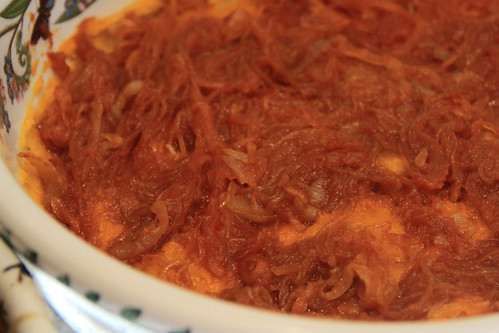
Zakuska in Russian refers to an appetizers or snack typically eaten with booze. In Romanian, the term has come to be applied to one specific dish, of roasted peppers and eggplants simmered for hours with other vegetables like onions and tomatoes until it's rich and spreadable. Zacusca is typically made at the peak and end of summer to preserve the bounty, and canned for year-round enjoyment.
I went a bit overboard and cooked it over a slow fire in the grill, figuring that since the eggplant ought to be fire-roasted, why not just keep the flame going gently. It was a novel way to cook, but unfortunately the hours of smoke didn't really seem to impart much flavor on the dish, so I just should have done it on the stovetop and saved myself a few blasts of smoke to the eyes. Anyway, it's tasty enough, and I'm sure it'd be a welcome jolt of flavor and vitamins in the middle of a long winter, but I didn't find it particularly exciting.
Fasole bătută | Mashed beans | Recipe (in Romanian)
Plenty of places mash up beans, but this method has the genius to add a lot of onion sauteed in a lot of oil and some tomato: half blended up (along with a lot of garlic) to make the mash proper, and the other half making a pretty topping. Very nice spread on bread, though next time I'd add a bit of chili pepper and maybe a bit more salt.
Mămăligă | Thick polenta | Recipe
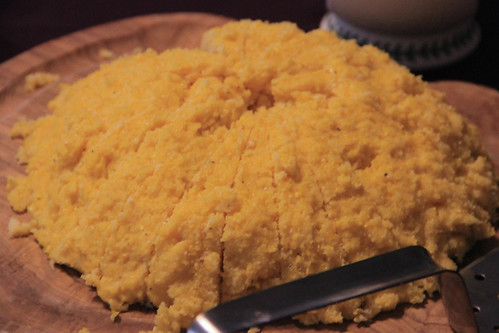
I knew that polenta, once cold, became something you could slice, fry, etc. But I didn't know that if you make it a bit thicker and dump it onto a board, you can slice it within a few minutes and hold it like a slice of bread. This is the core of Moldovan cuisine, and it's very convenient and cheap and filling and satisfying, especially if you mix a bit of butter in.
Mujdei | Garlic sauce | Recipe
There seem to be infinite recipes for this condiment, but I'm going to go out on a limb and say this is among the best. Garlic actually constitutes only a fraction of the ingredients, the rest being onions and a lot of butter in which the onions were fried, plus a bit of lemon juice and salt. The result is a rich, versatile, and insanely delicious spreadable sauce that I'm putting on just about everything now, and you should too.
Sarmale cu nuci | Walnut-stuffed cabbage rolls | Recipe
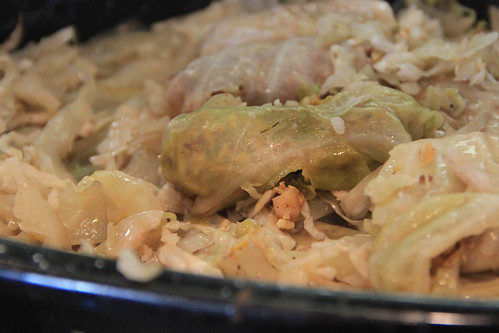
These little bundles of joy are a direct, and delicious, descendent of Turkish dolmas. Rather than grape leaves, these are preferably made with whole-leaf sauerkraut (see above discussion of Moldova's pickling), but that's hard to find and I should have started it a few weeks prior so I just blanched fresh cabbage leaves. These are typically made with some sort of ground meat, but Valeria, who'd done Peace Corps in Romania, suggested we could use ground walnuts to keep it vegetarian. What a fantastic idea, a great balance to the homogeneously soft texture of everything else after the better part of a day in the crockpot. Note on the recipe: on a hunch, I used two heads of cabbage instead of one while keeping the rest of the recipe the same, and the proportions worked out right.
Salata de vinete | Eggplant salad | Recipe

This recipe's a bit more of a production than most that I found, with bold additions like prunes and mint and pine nuts, but as a Kachka partisan I had to make their Moldovan eggplant salad. It was pretty good, with a nice variety of textures, though I wish I'd made it a bit spicier (I used sririacha and under-dosed out of an abundance of caution), and it probably could stand to be more oily. It also, frankly, felt pretty redundant with the zacusca, I'd recommend making one or the other.
Ghiveci de ciuperci | Mushrooms in sour cream | Recipe
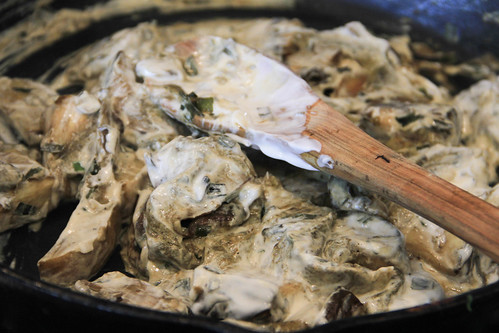
My god, another dish?! Well, I wasn't planning it, but when I found a porcini mushroom the size of my face at the farmers market, I figured I'd find a use for it. Indeed, here's a classically Eastern European preparation, smothered in sour cream. I left out the bacon because vegetarians, and I'm sure that would have tasted great, but there was plenty of flavor and texture to go around. Worth a go, even if all you have on hand is normal mushrooms.
Plăcinte cu vișine | Sour cherry flat pie | Recipe
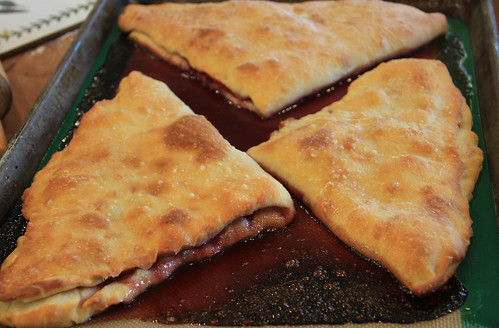
If that word looks like "placenta" to you, congrats, you're right. But the naming went the opposite way from what you may think: the flat pie came first, in Greek, and then someone thought that this component of pregnancy bore enough resemblance to the food to merit adopting the name. Anyway, it's made with a wide variety of sweet and savory fillings, with simple or complex dough, pan-fried or baked.
I'm sure they can be very good, but this one was a disappointment. The dough turned out too thick, the filling insufficient, and the flavors unexciting. Perhaps it was my error — certainly not that of Nancy, who did a fantastic job rolling and folding! — but I'm certainly not craving this again. If you've got a need to cook this, I'd look to do it in a pan, if only to get some extra flavor from the frying.